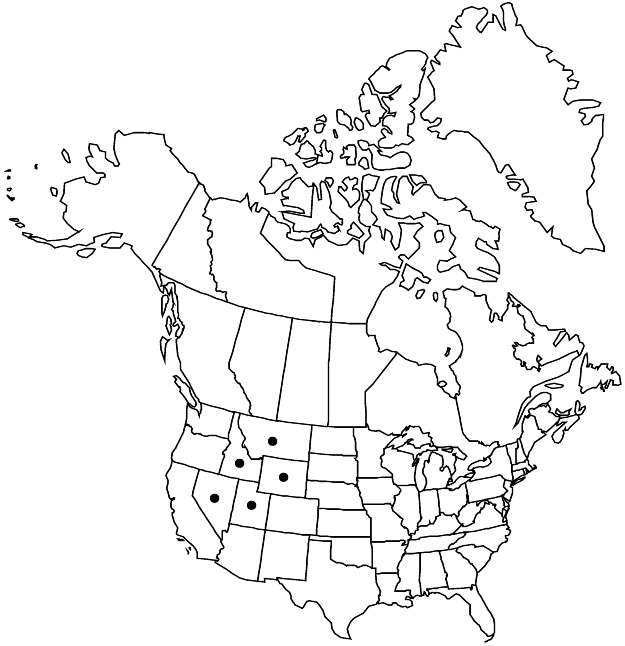Difference between revisions of "Eriogonum umbellatum var. desereticum"
Great Basin Naturalist 35: 365. 1976.
FNA>Volume Importer |
imported>Volume Importer |
||
| (2 intermediate revisions by one other user not shown) | |||
| Line 8: | Line 8: | ||
}} | }} | ||
|common_names=Deseret sulphur flower | |common_names=Deseret sulphur flower | ||
| + | |special_status={{Treatment/ID/Special_status | ||
| + | |code=E | ||
| + | |label=Endemic | ||
| + | }} | ||
|basionyms= | |basionyms= | ||
|synonyms= | |synonyms= | ||
| Line 24: | Line 28: | ||
|elevation=(1500-)1900-3300 m | |elevation=(1500-)1900-3300 m | ||
|distribution=Idaho;Mont.;Nev.;Utah;Wyo. | |distribution=Idaho;Mont.;Nev.;Utah;Wyo. | ||
| − | |discussion=<p>Variety desereticum is widely scattered in southern Idaho (Bear Lake, Blaine, Custer, and Owyhee counties), southwestern Montana (Park County), and southwestern Wyoming (Carbon, Teton, and Uinta counties) south into northeastern <i>Nevada</i> (Elko County) and northern Utah (Box Elder, Carbon, Daggett, Duchesne, Emery, Juab, Millard, Piute, Rich, Salt Lake, Sanpete, Summit, Tooele, Utah, and Wasatch counties). It is common only in Utah and southeastern Idaho. Variety desereticum is related to < | + | |discussion=<p>Variety desereticum is widely scattered in southern Idaho (Bear Lake, Blaine, Custer, and Owyhee counties), southwestern Montana (Park County), and southwestern Wyoming (Carbon, Teton, and Uinta counties) south into northeastern <i>Nevada</i> (Elko County) and northern Utah (Box Elder, Carbon, Daggett, Duchesne, Emery, Juab, Millard, Piute, Rich, Salt Lake, Sanpete, Summit, Tooele, Utah, and Wasatch counties). It is common only in Utah and southeastern Idaho. Variety desereticum is related to <i></i>var.<i> dichrocephalum</i>, but the two rarely occur together. Late in the season, high-elevation plants can have attractive, bright red leaves. Such plants approach <i></i>var.<i> porteri</i> in aspect, especially in the Jarbidge, Ruby, and East Humboldt mountains of <i>Nevada</i>. The Deseret sulphur flower is worthy of cultivation.</p> |
|tables= | |tables= | ||
|references= | |references= | ||
| Line 33: | Line 37: | ||
-->{{#Taxon: | -->{{#Taxon: | ||
name=Eriogonum umbellatum var. desereticum | name=Eriogonum umbellatum var. desereticum | ||
| − | |||
|authority=Reveal | |authority=Reveal | ||
|rank=variety | |rank=variety | ||
| Line 47: | Line 50: | ||
|publication title=Great Basin Naturalist | |publication title=Great Basin Naturalist | ||
|publication year=1976 | |publication year=1976 | ||
| − | |special status= | + | |special status=Endemic |
| − | |source xml=https:// | + | |source xml=https://bitbucket.org/aafc-mbb/fna-data-curation/src/2e0870ddd59836b60bcf96646a41e87ea5a5943a/coarse_grained_fna_xml/V5/V5_691.xml |
|subfamily=Polygonaceae subfam. Eriogonoideae | |subfamily=Polygonaceae subfam. Eriogonoideae | ||
|genus=Eriogonum | |genus=Eriogonum | ||
Latest revision as of 22:13, 5 November 2020
Herbs, spreading mats, 1–3.5(–4) × 3–6 dm. Aerial flowering stems erect, 1–3 dm, thinly floccose or glabrous, without one or more leaflike bracts ca. midlength. Leaves in loose rosettes; blade usually elliptic, 1–2(–2.5) × 0.5–1.5(–2) cm, glabrous on both surfaces at full anthesis, margins plane. Inflorescences umbellate; branches 2–4.5(–5.5) cm, glabrous, without a whorl of bracts ca. midlength; involucral tubes 2–3 mm, lobes 1–2.5 mm. Flowers 4–8 mm; perianth pale yellow to cream.
Phenology: Flowering Jun–Sep.
Habitat: Sandy to gravelly slopes and ridges, mixed grassland and sagebrush communities, oak, aspen, and montane to subalpine conifer woodlands
Elevation: (1500-)1900-3300 m
Distribution

Idaho, Mont., Nev., Utah, Wyo.
Discussion
Variety desereticum is widely scattered in southern Idaho (Bear Lake, Blaine, Custer, and Owyhee counties), southwestern Montana (Park County), and southwestern Wyoming (Carbon, Teton, and Uinta counties) south into northeastern Nevada (Elko County) and northern Utah (Box Elder, Carbon, Daggett, Duchesne, Emery, Juab, Millard, Piute, Rich, Salt Lake, Sanpete, Summit, Tooele, Utah, and Wasatch counties). It is common only in Utah and southeastern Idaho. Variety desereticum is related to var. dichrocephalum, but the two rarely occur together. Late in the season, high-elevation plants can have attractive, bright red leaves. Such plants approach var. porteri in aspect, especially in the Jarbidge, Ruby, and East Humboldt mountains of Nevada. The Deseret sulphur flower is worthy of cultivation.
Selected References
None.